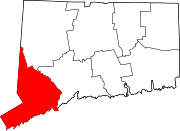Greenfield Hill, Connecticut: Difference between revisions
fix loc |
refine cat |
||
| Line 38: | Line 38: | ||
[[Category:Fairfield, Connecticut]] |
[[Category:Fairfield, Connecticut]] |
||
[[Category:Neighborhoods in Connecticut]] |
[[Category:Neighborhoods in Connecticut]] |
||
| ⚫ | |||
| ⚫ | |||
[[Category:1750 architecture]] |
[[Category:1750 architecture]] |
||
Revision as of 01:04, 24 June 2009
Greenfield Hill Historic District | |
| Location | Roughly bounded by Meeting House Ln., Hillside Rd., Verna Hil Rd. and Bronson Rd., Fairfield, Connecticut |
|---|---|
| Built | 1750 |
| NRHP reference No. | 71000899 [1] |
| Added to NRHP | March 11, 1971 |
Greenfield Hill is an historic neighborhood of Fairfield, Connecticut. Located in the northern part of the town, it extends from just south of the Merritt Parkway to the town's boundary with Easton, to the north.
Along with Southport, Greenfield Hill is one of two notably affluent neighborhoods in Fairfield. Thanks in large part to the efforts of the Greenfield Hill Village Improvement Society [1], zoning is residential and lots are 2 acres (8,100 m2) or larger.
Locally, Greenfield Hill is known for its Dogwood Festival, which celebrates a variety of tree that abounds in the neighborhood. The most famous and perhaps the most picturesque landmark is the Greenfield Hill Congregational Church [2], which presides over a classic New England green. Timothy Dwight IV, best known as a president of Yale University (and the namesake of one of its residential colleges) was pastor of Greenfield Hill Congregational Church for many years. According to local lore, he was hired by Yale to thwart plans for a rival educational institution in Fairfield.
Besides Dwight, famous residents of Greenfield Hill have included Robert Penn Warren, the author of "All the King's Men," and Leonard Bernstein.
References
- ^ "National Register Information System". National Register of Historic Places. National Park Service. 2009-03-13.


